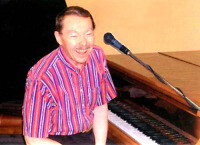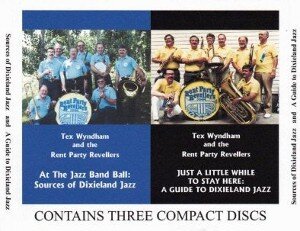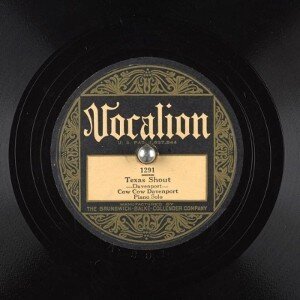 Set forth below is the forty-fifth “Texas Shout” column. The concluding portion of a two-part essay, it first appeared in the November 1993 issue of the West Coast Rag, now The Syncopated Times). Read part one.
Set forth below is the forty-fifth “Texas Shout” column. The concluding portion of a two-part essay, it first appeared in the November 1993 issue of the West Coast Rag, now The Syncopated Times). Read part one.
Today’s uptown jazzmen/women naturally turn toward recordings of their favorite artists for source material. The tunes recorded by Bunk Johnson, George Lewis, Kid Thomas Valentine, Billie and De De Pierce, etc., have become staples of the contemporary uptown repertoire.
In some cases, the pioneering musicians did not fully remember the tune as the composer originally wrote it. In those cases, they simply made up the missing parts. This procedure will work well enough as long as everyone in the band has the same understanding of what melody and chords are to be played at any given time.
Sometimes memories were sufficiently faulty that what emerged was an entirely original composition. Bunk Johnson’s 1942 recording of “Bluebells Goodbye,” for example, is almost surely an attempt to recall “Bright Eyes. (Good Bye.)” (1905), words by Harry H. Williams, music by Egbert Van Alstyne. However, Johnson undoubtedly got the song mixed up in his mind with “Blue Bell” (1904), words by Edward Madden, music by Theodore F. Morse, also a march-like tune with a lyric about a man bidding farewell to his love. The result, “Bluebells Goodbye,” is in fact a brand new tune that doesn’t resemble either of its sources in more than a superficial way.
In such cases, jazz bands wanting to play those numbers will, of course, use the early uptown records as a model. They are the definitive versions of these “new” titles.
There are other cases where pioneering uptown bands have played standard tunes, ones familiar to most Dixieland players, and not followed the accepted versions of the chords or melody. In such instances, revivalist uptowners have typically tacitly “corrected” the music and used the standard practices.
Some tunes occupy a middle ground. These are selections that are not particularly obscure but which are primarily played only by uptown New Orleans Dixielanders, and where the common practice is to follow the recordings rather than the sheet music. One example that readily comes to mind is “Ice Cream.”
“(I Scream – You Scream – We All Scream For) Ice Cream” (1927), by Howard Johnson, Billy Moll, and Robert King, is a clever novelty ditty about a college for Eskimos. As originally written, the lyric to the first chorus is (spelling and punctuation per the original song sheet):
I scream, you scream
We all scream for Ice Cream
Rah! Rah! Rah!
Tuesdays Mondays
We all scream for Sundaes
Siss! Boom! Bah!
Boola Boola Sasparoola
If you’ve got Chocolet
We’ll take Vanoola
I scream, you scream
We all scream for Ice Cream
Rah! Rah! Rah!
George Lewis’ drummer/vocalist Joe Watkins obviously did not remember this lyric and instead sang what seems to me to be meaningless gibberish. Here is Watkins’ version, from the first chorus of his vocal of June 18, 1953 as recorded on Delmark DL-201:
You scream, I scream
Everybody wants ice cream
Rock, rock my baby rock.
You scream, I scream
Everybody wants ice cream
Rock, rock my baby rock.
Osceola, R.C. Cola,
Everybody wants a Pepsi-Cola.
You scream, I scream
Everybody wants ice cream
Rock, rock my baby rock.
To me, it is perfectly obvious which of the two lyrics has the superior claim to be rendered. Nevertheless, despite the fact that the sheet music to this tune is reprinted from time to time in folios of twenties songs, the Watkins version is essentially the only one heard from Dixieland stages.
Similar discrepancies occur in tune titles. “Panama” (1911) by William H. Tyers and “Hiawatha (A Summer Idyll)” (1901) by Neil Moret (pseudonym for Charles N. Daniels) are commonly played by uptowners under the respective titles “Panama Rag” and “Hiawatha Rag”. However, as indicated, the word “rag” does not appear in the title of either. Moreover, from a musical viewpoint, neither one is in fact a rag – “Panama” is written entirely in Latin time, while “Hiawatha” is completely unsyncopated.
Along the same lines, the familiar Dixieland flag-waver “Weary Blues” (1915), by Artie Matthews, is frequently played by uptowners under the title “Shake It And Break It.” Apparently this title comes from a line of a lyric sometimes sung to the chorus which begins “You shake it, you break it, you hang it on the wall …”
I point out these “errors” not to criticize the pioneering uptown musicians, who created immortal jazz and some of my favorite performances. These musicians were not schooled and were certainly not musicologists.
I mention them because I believe that, as we follow their footsteps in light of information easily available today, we need not necessarily adopt the same practices. I see no reason, for example, why today’s musicians shouldn’t play a tune under the title the composer gave it.
Why create audience confusion by playing “Weary Blues” as “Shake It And Break It?” Especially when “Shake It And Break It” (1920), words by H. Qualli Clark, music by Signor Friscoe Lou Chiha, an entirely different number, was recorded by a number of famous jazzmen during the vintage years and is still played today?
For that matter, some possibility of audience confusion is created by playing “Panama” as “Panama Rag.” There is, after all, a piece entitled “Panama Rag,” a ragtime piano solo written in 1904 and published as by Cy Seymour (believed to be a pseudonym for W.C. Polla). The rag is currently in print in a folio from Dover Books and probably is heard occasionally at ragtime gatherings.
With respect to actual changes in the music itself, as with the lyrics to “Ice Cream,” I believe that a jazzman ought to try, if reasonably possible, to present the number as its composer wrote it. That is, I think the proper starting place is the published sheet music, which is not as hard to locate for many selections as one might think. During the sixties, when I really started digging into this music in earnest, I was amazed at the number of times I would try calling a New York publisher about some tune from the twenties to discover that it was still in print and could be sent to me for seventy-five cents plus postage.
Sometimes, after examining the music or comparing it to recorded versions, an artist will decide that certain modifications need to be made if the piece is to swing comfortably as a jazz vehicle. I have no problem with such decisions, as long as the artist has given the subject some independent thought. I have trouble with mindlessly copying what someone – even one of the all-time great jazzmen – happened to do one day years ago in a recording studio for reasons we can never know (which might include, for example, being tired or preoccupied and thereby not bringing his best skills to bear on what he was doing).
I have gone through this sermon because the uptown style is the branch of Dixieland that has, in its original source recordings, the largest number of pitfalls of this type for those who are coming along behind. Let’s keep the best parts of that heritage by all means, but remain alert to areas where we can add elements that will enhance it.
Before leaving this subject, I want to touch on two elements of the mythology of uptown New Orleans. One deals with the alleged primacy of the style and the other deals with its view of elderly musicians.
Uptown buffs are known to claim that this style was the first known jazz style and that all later Dixieland styles, and indeed all other subsequent jazz forms, are somehow less pure and authentic. I doubt that anyone can be certain which of the three New Orleans Dixieland styles came first or how quickly the other two followed in its wake.
Still, the claim for primacy of uptown New Orleans seems plausible enough to me because, as I have previously mentioned, it is the least technically sophisticated of the three. However, that fact is surely of no more than historical interest and does not support any kind of implication that the style itself has some sort of superior claim to the attention of jazz buffs.
The artistic merit of jazz styles does not in any way depend on their chronological age. All styles, when performed by skilled artists who understand the genre, are equally “authentic” examples thereof.
A mediocre rendition of uptown New Orleans Dixieland, or any other style, is mediocre no matter how you slice it. Such a performance is not more worthy of our time than a superior performance in Chicago, West Coast revival, etc., just because uptown New Orleans appeared on the scene earlier. Similarly, mediocre swing or bop performances have no claim to superiority over outstanding Dixieland performances just because swing and bop are later styles and are, in the eyes of their supporters, more “advanced” or “up to date” than Dixieland.
It is commonly believed by the jazz community that Bunk Johnson and the other musicians who sparked interest in uptown New Orleans were elderly musicians. This notion has been romanticized in some circles into a hagiology that seems to consider Dixieland musicians of advanced age, particularly Black musicians from New Orleans, as having some kind of special understanding of the “authentic,” “original,” “correct,” or whatever, way to play jazz. I have no doubt that much of The Preservation Hall Jazz Band’s appeal to the non-jazz audience comes from its implicit (and sometimes explicit) fostering of ideas along those lines.
While the uptowners of the 1940s revival were no longer youths, they were not old men. On December 1, 1945, the time when Johnson’s most fondly recalled lineup was in the process of making a series of recordings for Decca and Victor that are usually ranked with his best, the average age of the seven musicians was 48 years and 1 month.
While playing a musical instrument is an activity that calls for a certain amount of physical strength and stamina, it is not so demanding that middle-aged people should be considered to be in danger of losing their talents. Indeed, the average age of many Dixieland bands on the festival circuit today is well above 48, including quite a few of the most popular and creatively potent units. As has been demonstrated time and again, jazz musicians in their fifties are still at a time of life when they can be expected to perform at peak.
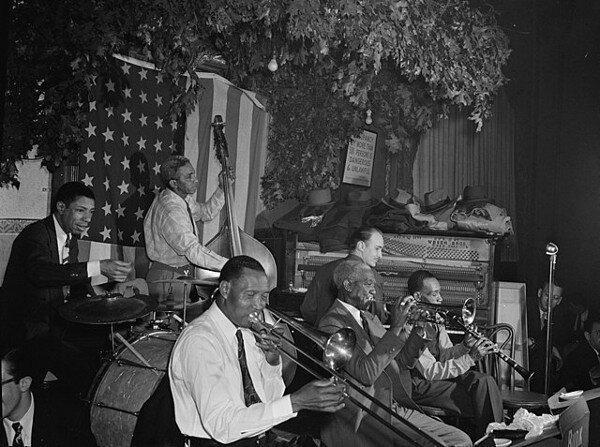
This is not true, on the average, when musicians reach their seventies and eighties. Of course, we can all cite many great ragtimers and jazzmen who continued to create great music in those years – Doc Cheatham, Bob Haggart, Alton Purnell, Yank Lawson, Milt Hinton, Art Hodes, Louis Nelson, Wild Bill Davison, Eubie Blake; the list is a long one.
However, advancing age affects different people in different ways. There have been many other truly elderly artists who, for one reason or another, did not retain the manual dexterity, breath control, imagination and other talents that are required to play worthwhile jazz.
I would be the last to deny such performers the adulation and acclaim that they have earned through a lifetime of distinguished contributions to our music. I have many times gone out of my way to attend appearances by artists whose jazz has given me much pleasure even though I knew before leaving the house that the show would be a dim echo of days gone by – and I thoroughly enjoyed myself in the bargain.
However, I think it is important to keep such matters in perspective. Given that we would all like to attract more fans to our music, we should recognize that we are not helping our cause in that respect by representing below-average outings by superannuated musicians well past their primes as examples of something our friends should admire for itself alone.
I am taking the trouble to make this point because I can’t forget what happened the last time that Nancy and I attended a concert by The Preservation Hall Jazz Band. On that evening several years ago, the lineup included a musician who had made historically important recordings in the vintage years.
While I was grateful to see him live for the only time in my life that I did so, my enjoyment was quickly dissipated upon discovering that he was so feeble that he was not only barely able to play his instrument but also could hardly struggle to his feet when the front line stood up for the out chorus. He died shortly thereafter.
We spent much of the concert feeling rather sorry for this gentleman. We also were considerably disturbed to observe that a band which presents itself to the general non-jazz public – the bulk of the audience at this particular show – as preserving the true jazz heritage would include in its presentation someone who was so clearly incapable of delivering on that promise.
That was the sixth time I had attended a concert by the PHJB. The first five were memorable. Thus, we may be placing too much emphasis on one night’s experience. However, we were so put off by what we saw that we have yet to be able to bring ourselves to attend another, even though the band appears annually at a theater about a half-hour from my home.
Perhaps, as is sometimes asserted, the veteran uptown musicians of the 1950s and 1960s were maintaining a form of jazz that they had played since the turn of the century and which was free of intervening influences. However, that is not the case now.
Musicians in their seventies today were born in the late teens and twenties. Many of them absorbed their initial jazz influences during a period of nationwide radio broadcasts and record distribution, at a time when the cutting edge of jazz was beginning to change from Dixieland to swing.
There can no longer be any reason to regard elderly musicians as special keepers of the flame of any Dixieland style. Indeed, many of the third-and-fourth generation revivalists on the scene today, most of whom learned the music in the same way as today’s “elderly” musicians, are doing a perfectly splendid job in that respect.
Records in the uptown style are fairly easy to find in any record store that emphasizes jazz. However, for comprehensive one-stop shopping by someone new to the idiom, I’d suggest contacting George H. Buck, Jr. and requesting a copy of his free catalog. The address is Jazzology Records GHB Jazz Foundation 61 French Market Pl. New Orleans, LA 70116. Phone: 504–525-5000. Fax: 504-525-1776. Email: geobuck@jazzology.com, website: www.jazzology.com.
Among his stable of labels, particularly on American Music, G.H.B. and Jazzology, George has many records of uptown New Orleans. These include all of the great names in the field, each of whom can be heard performing at his/her best on one or another of George’s releases.
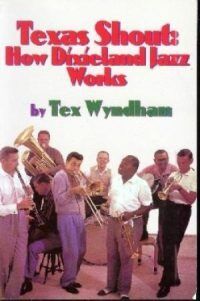 Want to read ahead? Buy the book!
Want to read ahead? Buy the book!
The full run of “Texas Shout” has been collected into a lavishly illustrated trade paperback entitled Texas Shout: How Dixieland Jazz Works. This book is available @ $20.00 plus $2.95 shipping from Tex Wyndham, On request, Tex will autograph the book and add a personalized note (be sure to tell him to whom the note should be addressed).
Tex Wyndham’s 3 CD Guide to Dixieland with music and commentary is available for $20 plus $2.95 shipping. The separate CD, A History of Ragtime: Tex Wyndham Live At Santa Rosa, is available for $13.00 plus $2.00 shipping. On request, Tex will autograph the inner sleeve and add a personalized note (be sure to tell him to whom the note should be addressed).
Send payment to Tex Wyndham, P.O. Box 831, Mendenhall, PA 19357, Phone (610) 388-6330.
Note: All links, pictures, videos or graphics accompanying the Shouts were added at the discretion of the Syncopated Times editorial staff. They did not accompany the original columns and do not necessarily reflect the opinion of Tex Wyndham.
From roughly 1970-2010, Tex Wyndham was: (1) one of the best-known revivalist Dixieland jazz musicians in the US, as cornetist, pianist and bandleader, (2) one of the best-known ragtime pianists in the US, and (3) one of the most respected critics in the US of Dixieland jazz, ragtime, and related music. He is the only person about whom all three of those statements can be made.

